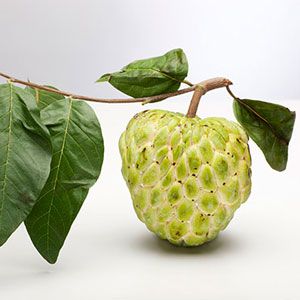It’s Easy to Grow Nona Fruit at Home: Make sure to use the right fertilizer

Grow Nona Fruits at Home
(Istimewa)Nona fruit or better known as srikaya is a tropical fruit that has a unique sweet-sour creamy white flesh and a scale-like rind. Most people who have tried nona fruit tend to say that it tastes like its relative soursop.
With a relatively the same look minus the soft spike, both fruits are delicious on their own as a juice or added into ketan (sticky rice) and dodol.
Not only does it taste delicious and fresh, but nona fruit is also loaded with nutrition to help boost immunity with its high amount of antioxidant polyphenols and vitamin C and help with healthy digestion from its high amount of fibers. It also has a high folic acid content recommended for pregnant women for the growth and development of the fetus. Now that you know a little bit about Nona fruit, let’s learn how to grow one of your own at home.
The first thing to know about growing a Nona tree at home is that it’s a low-growing tree that usually does not exceed 7 meters in height. As with other fruit trees, it needs quite a large space to properly grow and produce. Next, you’ll need to pick the seeds. You can germinate your nona fruit seeds from the fruit you ate, but the result of that tends to be unreliable. You can plant seeds from a sweet nona fruit then have a not-so-sweet one. This is because nona fruit seeds are heterozygous and undergo a breakdown of properties from seed to seed. Other methods of seeding are using saplings from already grown trees. These saplings are sold and come from vegetation propagation of the parent nona tree.
After you get the seeds, prep the growing media, it can be a big pot or straight on the soil with a little land management. The growing media usually contains soil and manure fertilizer. To make things easier, you can use a tablespoon or around 10 grams of Ecofert fertilizer to add to the soil. The organic fertilizer contains microorganisms that can increase the fertility of the soil and save the amount of NPK fertilizer by 25%.
When the growing media is ready, make a hole for the sapling to go in. Usually, the sapling would come in a polybag. You can remove the polybag or make long cuts down the sides for easier handling, this way when the root expands it has spaces to go. Cover the plant with more soil and water it. Take note to water more on the soil and roots and less on the leaves. And voila you just planted your very own Nona tree.
Dosage of fertilizer for Nona fruit from the beginning of planting until before harvest
Tending to nona tree is not much different than most fruit trees. It needs proper food from fertilizer and watering to make sure that it properly grows and produces.
Nona Fruit trees need routine watering. Especially during the dry season where it had little to no rain. The rule of thumb to follow is if you scorch the soil by around 5 cm deep and the soil is still wet, then hold off on the watering. But if the soil is dry then you know it’s time to water them. Careful not to overwater because it can cause disease from molds or bacteria to attack the plant. While lack of water can cause the flower to fall out and produce less fruit.
Fertilizer application can be done every 3 months to ensure there’s enough supply of nutrients to the plant. 25 grams of fertilizer such as the NPK Pelangi fertilizer with an equal ratio is recommended for the first months of planting. Depending on how old the seeds or saplings you choose, the guide for fertilizing nona plants according to the Indonesian Agency of Agricultural Research And Development are as follows:
- 6 month old: NPK 227 gr/tree
- 1 year old: NPK 454 gr/tree
- Second year: NPK 1 kg/tree
- Third year: NPK 2 kg/tree
- Fourth year: NPK 2 kg/tree
- Fifth year and above: NPK 5 kg/tree
After the fruit appears, do the selection. Keep only fruits that are symmetrically round in shape. If there are two fruits in one branch that is near one another (less than 20 cm) then discard one of them. This is so that the food supply to the fruit is sufficient to raise the fruit to its maximum size. Nona fruit tends to attract flies and other pests as they grow, to prevent that, wrap or brongsong the fruit loosely with plastic so that it has space to grow further. Make sure that the wrap being used is transparent so it can still have access to sunlight. Then apply fertilizer with a higher content of P (phosphorus) and K (potassium) to ensure the fruit grows big and well.
